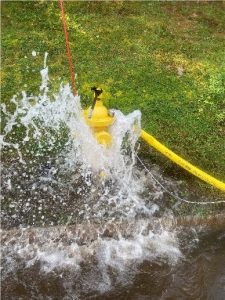OBSERVATIONS AND LESSONS FROM THE SCHOOL OF EXPERIENCE
After more than 30 years in the industry, we’ve amassed some great takeaways pertaining to the work we do. We felt this key information was important to share, so in 1996, Lessons Learned was created as a mailed piece sent out to our peers. Now, we are pleased to offer Lessons Learned electronically once a month, accessible on this page or delivered directly to your inbox when you sign up.
Fire Hydrants
Facilities Engineering Services

Most of us normally don’t notice the fire hydrants along our streets and in our neighborhood, even though they serve an important purpose. Fire hydrants are covered by one or more standards developed by the National Fire Protection Agency (NFPA) or the American Water Works Association (AWWA). There are generally two groups of hydrant owners, private and public. Most of us see the public hydrants since they are found along the street and in public spaces. Private hydrants are often found on large private tracts, developments or private campus areas that may not have easements for public utilities.
Hydrants are supplied by the public domestic water system, same as the water tap in the kitchen. During construction, a tap will be made for the domestic water supply and an additional tap for fire water supply. During the life of the system, public hydrants are typically tested by the fire department. They do this during down time when not fighting fires to keep the public system maintained. However, the public fire department does not test or maintain private hydrants.
It is important to understand the purpose of the hydrant and how it works within the larger fire protection system. When a fire event occurs, if there is a fire sprinkler system, the sprinklers in the fire area will pop and spray the fire. When the fire engine arrives, the truck houses a pump and a house. The fire department does not normally bring water, because it is in the domestic system. The hydrant is the access point for the fire engine truck pump. In a small fire, the fire department can use the smaller connections on the hydrant to fight the fire. As the fire grows in size, more water and water pressure is required. So the fire engine or pump truck will connect to the hydrant and then pump the water into hoses. But ultimately the water is from the same source, the domestic water. The hydrant is a window to the health of the entire system by allowing testing to determine pressure and flow.
Building upon this background information, ECS recently had the opportunity to test a significant number of private hydrants across the country. While most were operational, there were some very interesting discoveries we can share that will demonstrate why private hydrant owners should have a testing and maintenance plan.
ECS found a hydrant that was locked out and no one had the key, including the property tenant or public fire department. While this may have been a private hydrant, since the fire department was not aware of the lock, providing water in an emergency would be delayed.
ECS found a hydrant with a hole drilled in the side. When opened, water came directly from the barrel and never reached the hose for firefighting. This impacts the pressure to the hoses on the hydrant as well as reduces flow if a pump is connected. In this instance there would also be a significant impact on property as the water inundates the area.
ECS found a hydrant that when the valve was opened, the water spewed out from around the barrel in addition to water streaming from the barrel underground. Either the hydrant had suffered corrosion or was damaged at some point.
ECS found several systems that appeared to have a very low flow. This could have been the result of development where the water supply did not keep up with demand. Alternatively, could have been the result of old piping that failed or become blocked with internal corrosion. Low flow or significantly reduced flow is a reason to ask more questions.
The lesson here is that all hydrants need to be tested regularly. So how does a private owner implement a testing and maintenance plan? First is a call to the local fire department and/or the local water purveyor to determine what they may require in the way of permits or standards for testing. Keep in mind the hydrant may be private, but the water is normally public.
From that foundation, a plan can be crafted for annual visual inspection to find any visual damage, locks, missing caps, etc. The plan should include flow testing at least every five years. More often if local growth is aggressive. If there is a public movement for improved water supply, that data can be a powerful tool. If your property or building is expanded, you will likely need to have this flow and pressure data verified to supply a larger fire suppression system. Share that flow data with the public fire authorities and develop a relationship with them. Remember, they are the ones you will need if a fire does occur, and your functioning water hydrant may be the difference in the extent of damage and recovery.
We hope this Lessons Learned will be helpful to you in planning your next project. For additional information, please contact your nearest ECS office for more info and support.
ECS Group of Companies
The ECS Group of Companies (ECS) is an employee-owned engineering consulting firm with more than 2,000 employees providing geotechnical, construction materials, environmental and facilities consulting services. ECS has grown to over 75 locations and five subsidiaries spread across the Mid-Atlantic, Midwest, Southeast and Southwest. The firm is ranked 68 in Engineering News-Record’s Top 500 Design Firms (April 2021) and 49 in Zweig Group’s 2021 Hot Firms (June 2021).

